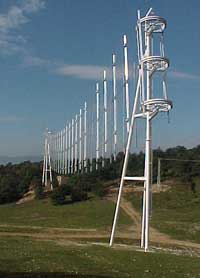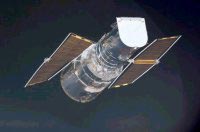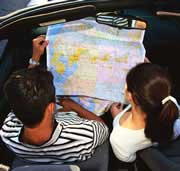A spherical prototype that can change its surface from smooth to dimpled cuts through drag and generates lift Captions // Photos on Flickr // Video on Youtube Underwater or aerial vehicles with dimples like golf balls could be more efficient and maneuverable, a new prototype developed at the University of Michigan has demonstrated. Golf ball dimples cut through pressure drag—the resistance force an object meets when moving through a fluid—propelling the ball 30% further than a smooth ball on average….

Positioning systems will become an essential tool for the carrying out of many different tasks in the future. Whether the problem consists of a tree falling on a power line or a car standing in the road with a motor failure, aid services will find a route straight to the right location by using this system.
It has previously been difficult for a person in need of aid to convey exact information about his location in an unfamiliar area. In future, the person can find his exact location with t

Whether it will compete for the title of a girl’s best friend remains to be seen but the element osmium can already challenge diamond in at least one respect: stiffness. According to a report published in the current issue of Physical Review Letters, osmium can withstand compression better than any known material. The results provide a potentially new lead in the search for superhard materials.
Diamond’s ability to resist scratches, dents and chipping–in short, its hardness–makes

Two Basque companies, Enerlim and NECESA, have developed a new wind generator, a wind reservoir to make use of wind energy.
This wind reservoir is much lighter than ordinary three-arm wind generators; hence, it is more economical and easier to install. On the other side, the machine is completely modular, as columns, pulleys and plates can be divided in order to make easier the production, transport and installation. The largest piece to be transported and installed is 12 meters long and 2

There are no in-car methods of detecting that a driver is too drunk to drive – until now. A team at Bristol University, led by physiologist Dr Dilwyn Marple-Horvat, has found a new way of detecting whether a driver has drunk too much to be fit to be at the wheel.
To assess a driver`s fitness to drive, a new device has been created that measures the degree of co-ordination between hand and eye. It uses: an in-car eye-tracker; a system that continuously monitors steering wheel movements; and

Neue Materialien mit nichtlinearen optischen Eigenschaften
Fensterscheiben und Brillengläser, die sich bei zunehmender Helligkeit dunkler färben, sind besonders im Sommer eine feine Sache. Optische Eigenschaften, die sich mit der Lichtstärke verändern, so genannte nichtlineare optische Eigenschaften, sind ihr Geheimnis. Auch als optoelektronische Bauteile sind derartige Materialien von Interesse. Voraussetzung für die besonderen optischen Eigenschaften ist eine sehr regelmäßigen Mikrostruktu

A new spin-out from Oxford University, Spinox, is aiming to devise novel ways to copy spiders` ability to spin silks. The new silks may be used for sutures or woven material for surgical implants, protective clothing and in sports equipment.
Spinox has been set up to fully develop a spinning process to create high performance fibres from natural or artificial proteins based on the principles used by spiders and insects to create natural silk fibres. This approach – biomimetic (mimicking biology)

The power for Hubble’s scientific discoveries comes from solar cells. Designing and constructing Hubble’s first two sets of solar cell arrays constituted a huge technological achievement for the European Space Agency and European industry. After an in-orbit life of more than 8 years, this example of pioneering space technology was this morning (European time) replaced by new, more powerful arrays.
For the last week a dedicated team of engineers, technicians and scientists from the European

European research co-ordinated by TU Delft
Offshore wind technology ready for application
The technology for the construction and operation of offshore windfarms is ready for large-scale application. Companies in the fields of engineering and services are preparing to take part. This can be seen in the conclusions of the project Concerted Action on Offshore Wind Energy in Europe (CA-OWEE) of the European Union, in which seventeen parties from thirteen European countries have brou

Materials scientists at the University of Wales Aberystwyth (UWA) are taking ceramics to new heights in order to determine the structure and stability of the materials which are used to construct aeroplane engines and the tiles for the space shuttle.
Dr Rudi Winter and colleagues from the Department of Physics at UWA are using a unique combination of techniques to study the materials at extreme temperatures which simulate those experienced when aircraft travel at high speed or when they dec

Europe is one step ahead of the US in the development of a new type of semiconductor structure consisting of incredibly thin nano threads. A Swedish team headed by Professor Lars Samuelson at the LTH, the Lund Institute of Technology, Lund University, has taken the lead in this field of research. “In nano threads, we can combine semiconductor materials that no one has previously been able to grow. This results in entirely new electrical properties: a single electron can be monitored and made to run a

The days of fast-fading cellular phone batteries may soon be over. Researchers at the Lawrence Livermore National Laboratory (LLNL) recently developed a working prototype for a portable fuel cell energy source that could power a cellular phone 300 percent longer than existing rechargeable batteries do. Indeed, the new technology would be less expensive, smaller and more powerful than any battery currently in use, according to Jeff Morse of LLNL’s Center for Microtechnology Engineering. He predic

France launches in Valenciennes a 6,4 million euro research program on transport safety. It reinforces the international position of Nord-Pas de Calais and the University of Valenciennes.
The scientific council of the New Research Action “Safety in Transport Systems”, which came together at the University of Valenciennes and Hainaut-Cambrésis on the 31st of January 2002, has just validated and launched a program composed of 7 projects stretched out until 2006. 6,4 million euros will b

The phrase `rain stopped play` is gloomily familiar to fans of Wimbledon, international cricket test matches and other major sporting tournaments.
But cancelling matches because the pitch is waterlogged could be consigned to history, thanks to new technology which could revolutionise the international world of both professional and amateur sport.
Researchers at the University of Newcastle upon Tyne are starting trials involving a completely new concept – Electrokinetic Geosynthetic

Match up folds to fight stubborn paper.
No road journey is complete without a wrestle with the map. Now a US computer scientist has worked out why the map usually wins.
Erik Demaine of the Massachusetts Institute of Technology in Cambridge has come up with an origami algorithm that predicts when a stubborn street plan will be re-foldable. “It’s the meeting of paper folding and computer science,” he says.
The rules governing whether a sheet of paper divided into a g

A computerised navigation system has been developed to enable wheelchair users to select the most accessible routes around a town centre. It means a journey can be planned that avoids obstacles like cobbled streets, steep areas and steps.
The work has been carried out by a team led by Professor Hugh Matthews, at University College Northampton, with funding from the Swindon based Engineering and Physical Sciences Research Council.
The ‘Wheelyroute’ system, believed to be the first

From cutlery and cooking pans to the inside of a Formula 1 car engine or a huge chemical process plant, stainless steel is all around us. It’s not meant to corrode, but it can, and when it does the results can be disastrous, whether it’s a hole in your dishwasher or a failed industrial plant.
Unlike rusting, stainless steel corrosion is highly localised and apparently random. Tiny holes called pits can drill through a substantial thickness of steel in a relatively short time. The pits can ca